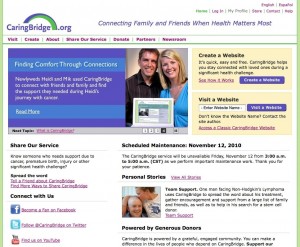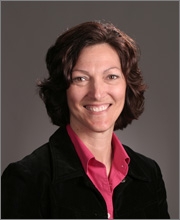 Which website has had over 1.5 billion visits since 1997 and helps patients and their families and friends more easily navigate a serious illness?
Which website has had over 1.5 billion visits since 1997 and helps patients and their families and friends more easily navigate a serious illness?
Twitter?
No.
FaceBook?
No.
CaringBridge
What?
CaringBridge.org hosts over 270,000 personal websites for free for families dealing with a serious illness or disease.
One of those websites was created by Beth Keathley in January of 2011 shortly after she was diagnosed with stage 3 pancreatic cancer. Her diagnosis arrived as she graduated with a nursing degree. It’s been nearly a year, since her diagnosis and Beth journals her progress and adventures on her personal website hosted by CaringBridge.
I spoke with Beth by telephone from her Florida home.
TCV: Thank you for agreeing to share your site and to talk with me. How did you find CaringBridge?
Beth: Thank you for being interested and sharing information about CaringBridge. I put out a mass eMail to my connections. It was hard eMailing people separately. One day while having breakfast with a friend, he suggested CaringBridge.
TCV: How did your friend learn about CaringBridge?
Beth: From a friend who was having a premature baby. It seems the only way to learn about CaringBridge is by word-of-mouth.
I had other questions, which Carolyn Egeberg, Vice President of CaringBridge, agreed to answer.
TCV: “What is CaringBridge?”
 Carolyn: It is an online site where families and friends may connect privately about a health issue. Whether it’s cancer, a problem pregnancy, or stroke, caregivers have a secure site to update and comfort each other.
Carolyn: It is an online site where families and friends may connect privately about a health issue. Whether it’s cancer, a problem pregnancy, or stroke, caregivers have a secure site to update and comfort each other.
TCV: How did CaringBridge get started?
Carolyn: In 1997, founder Sona Mehring received a call from a close friend asking how she could notify her family and friends as soon as possible about her life-threatening pregnancy.
TCV: What did she do?
Carolyn: Working in the technology industry and with three children of her own, Sona (rhymes with Donna) created a website for her friend to post updates. During that time only 35% of U.S. adults were using the Internet; the website allowed family and friends to communicate and share support.
TCV: How did Sona’s friend do?
Carolyn: Sadly, Baby Brighid died shortly after birth. The baby’s name, Brighid, was adapted to Bridge, and CaringBRIDGE was born in legacy of her memory.
 CaringBridge is focused.
CaringBridge is focused.
During a time when social media sites offer too many options and can get too complicated for a person struggling with an illness, CaringBridge, based in America’s Midwest, helps people in over 200 countries with one goal–to connect “family and friends” when health matters most.”
According to the website, CaringBridge.org keeps loved ones informed during a significant health challenge in two ways:
Simplifying Communications by reducing time and energy spent on repeated phone calls and eMails.
Providing Encouragement by creating a network of support for family and friends to post messages.
Hospitals, hospice, and other organizations refer CaringBridge to their clients/patients and their families as a way to get much-needed support during an illness. Carolyn adds: Eighty-eight percent of CaringBridge users report that CaringBridge positively impacted their healing process.
Members can easily create their personal websites at CaringBridge.
Beth: “It only took me an hour.”
The sites give families the following ways to update family and friends:
- My Story (an overview of the health challenge)
- Journal (similar to a blog to post updates)
- Guestbook (Guests are invited to sign in with their eMail in order to receive updates. People can visit anonymously, too.)
- Photos
- Tributes (Guests can make donations; the primary way in which CaringBridge receives funding.)
- Resources (Links to informative sites that will prove helpful.)
During the last ten months since her diagnosis, Beth says, “You learn to add items to your bucket list because you know your time may be brief.” She posts each new event to her journal on her CaringBridge site.
During the last two months she and her husband, Rick, have been to Israel, laughed heartily at a comedy club, and enjoyed the rides in Orlando.
“Rides? Didn’t you get motion sick?” I asked.
Beth: “I expected I would so I took extra anti-nausea pills and rode The Hulk, Dr. Doom, and even Harry Potter.”
Beth has learned that each day matters and she looks for the joyful moments during her journey. Her faith remains strong and she rests secure knowing what will be will be.
Her personal website through CaringBridge, gives her strength, and she continues adding items to her bucket list. She says, “I’ve done everything I need to do. If I leave this life sooner, I’ll leave no loose ends.”
That’s amazing when you think about it. Who can say that?
I am impressed by Beth’s courage and that she’s still getting out and doing things–FUN things–while checking off items on her Bucket List.
TCV: May I share your website with The Caregiver’s Voice visitors?
Beth: Yes. Even though I have a healthcare background, I have nothing to hide and I have no hang-ups about HIPAA [HIPAA Laws – The Privacy Rule, TCV Ed.]. If my site can help one person when I leave this world, I will consider it worthwhile.
After exploring the CaringBridge site and talking with these two ladies, my hope is that caregivers for cognitively impaired adults resulting from stroke, cancer brain, trauma, Alzheimer’s and other causes of dementia, create personal websites on the CaringBridge site to gain comfort, support, and strength; and that professionals refer people to the site.
Beth might say, “You’re only an hour away from creating your own support network.”
Brenda Avadian, MA
Alzheimer’s / Dementia Caregiver, Expert Spokesperson, Coach, and Author
SIGN UP for The Caregiver’s Voice monthly Newsletter
Links for further information:
About CaringBridge
Beth Keathley’s Personal Website at CaringBridge
DaynaBrown’s Personal Website at CaringBridge















There are numerous social networking sites enabling the connection of family and friends as a means of providing updates on a medical procedure or overall well-being following a surgical event. Few sites; however, capture the daily struggles of coping with a condition(s) with anonymity and international reach to those who share conditions and want to show support.
Why is this important? Most begin to feel guilty sharing the details of their condition(s) with family members/friends and would rather connect with those who have empathy and understanding and seek the same level of support. As much as our families love us, they can never truly grasp the challenge without having personally lived it.
In 2004, at 34-years old I was diagnosed with melanoma, a term I had never heard before. In an attempt to calm my fears, I searched the Internet to learn more about the stage-three skin cancer I was up against and never found the connections I was hoping for.
Today, understanding first-hand the amount of support those dealing with complex medical conditions need, I created TreatmentDiaries.com – a community focused on support for those who need more than a communication tool out to friends and family, who don’t have time to attend at physical support circle, or want a little more anonymity, or just need support on a more regular basis. Members (caregivers, patients, friends and family) turn to the Treatment Diaries site to share their thoughts about the medical battles they’re fighting privately or publicly through condition-specific web pages that connect members sharing similar medical struggles and to share the things they often can’t say out loud to those they know.
A dear friend of mine is fighting for her life with a breast cancer diagnosis and using both Caring Bridge and Treatment Diaries – she likes both. In fact, she loves the opportunity to communicate in a single post to those who know her, but she also takes full advantage of the anonymity offered on Treatment Diaries and the freedom to share her inner most fears, concerns, and despair without setting off the alarms with friends and family.
For me it’s about never feeling alone again, no matter the condition, stage or prognosis. Patients, caregivers, family members and advocates all need to feel support and inspiration from those who can identify with their journey.
TreatmentDiaries.com was inspired by real stories of people struggling with chronic conditions, caring for those with an illness and in desperate need of support. The goal is to connect those facing similar circumstances and facilitate the sharing of valuable information and support at every stage of an illness through wellness.
Finding and sharing genuine information and experiences is a powerful thing, and this tool gives people the opportunity to do just that.
[UPDATE 10/22/2018 The Caregiver’s Voice Editor: Treatment Diaries website can no longer be reached.]
Amy, thank you for taking time to comment and to share how Treatment Diaries can be another useful resource for family caregivers and their loved ones navigating a serious illness or disease.
I wish I knew about this website before my sister died of pancreatic cancer. It may have provided her with some peace and comfort knowing she was not alone. Spread the word …